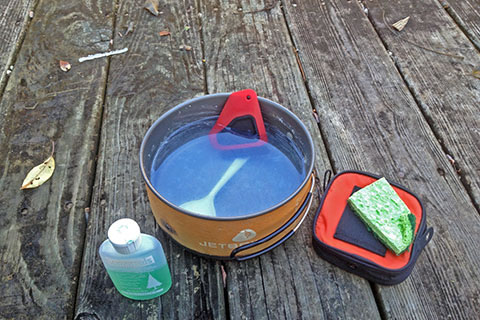| 867 | Camping Kitchen Clean Up |
2013-10-09 |

Hey, where's the dishwasher when you need it?
I have never met a camper who enjoys cleaning the dishes after a big meal. Whether it is campground or backcountry cooking, cleaning is not an easy chore. To compound the task there are also environmental and safety concerns.
To help alleviate clean ups, we cook simple meals. In the backcountry we pack make-in-the-bag freeze dried or dehydrated meals for dinner and non-cook breakfasts and lunches. We use the stove for boiling water and have virtually no clean up.
While at campgrounds and/or car camping, we sometimes follow recipes that require more cooking than just boiling water. Then we have cleaning chores. I do not enjoy cooking, sort of seems like a waste of time to me, so I have had plenty of practice perfecting my cleaning skills (my wife also cleans the dishes but as a rule whoever cooks does not have to clean. She cooks, I clean.)
To help with the chores we have a small cleaning kit:
Campsuds - a biodegradable soap concentrate. It has suds in hot or cold water. Unfortunately it also has a soapy smell. If it was odor free, it would be the perfect suds. In the campground after washing, we dispose of the "dirty" water in the drain, if a washing drain (or tub) is provided. When there are no clean up facilities, we remove the food scraps from the water and spray the "dirty" water over the road. We do not take soap into the backcountry, but if you did, it would be appropriate to remove the food particles from the "dirty" water and then pour the water in a cat hole located at least a couple of hundred feet from water sources and even further away from camp.
MSR Alpine Dish Brush/Scraper - our favorite dish cleaner. The brush is made of a stiff bristle and easily cleans the corners of a pot. The bristles are easy to clean and dry. The tool can also be used as a scrapper with each side cut for a different angle.
Sponge/scrubber - this is just a standard scrub sponge from the kitchen that we cut to a smaller size. It helps remove the stubborn stickiness.
Container - we pack our kit in the square-ish container originally used to store the Sea to Summit Folding Bucket. It is the perfect size for the kit and has a drainage hole.
A few other cleaning tips ...
We use hot water when possible. Some restrooms have hot water, but the cleaning stations do not. We use the Folding Bucket or a thermos to capture the hot water to use for cleaning.
If no hot water is provided, we boil water and collect it in a thermos and then take the hot water to the cleaning location. The big Hydro Flask (64 ounce) growler works the best.
The pot we cook in regularly, we do not waste a lot of time with cleaning. We use the pot each day for boiling water so we do not use soap on the pot unless we are using the pot as a wash basin for other dishes.
Certain dishes are easier to clean than others. We carry the origami bowls because they are lightweight, versatile, and so easy to clean.
Not all cookware is created equally. The surface on the Jetboil pans are easy to clean and basically indestructible. Of course, we have several Jetboil products and are definitely fans.
The Sea to Summit Kitchen Sink makes a nice cleaning basin.
The Sea To Summit Folding Bucket allows you to carry 8 liters or so of water far away from the source for clean up.
Commit to Minimum Impact Usage. Learn and practice accepted procedures for cleaning dishes and always be thinking of even better ways to lessen impact.
Happy squeaky clean trails